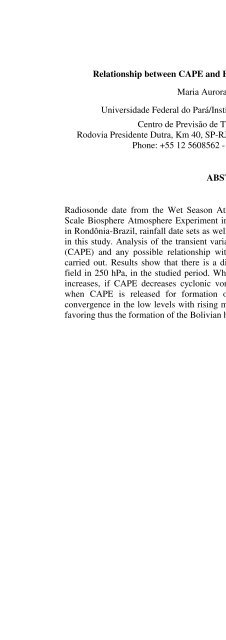A Look at Amazon Basin Seasonal Dynamics with the Biophysical ...
A Look at Amazon Basin Seasonal Dynamics with the Biophysical ... A Look at Amazon Basin Seasonal Dynamics with the Biophysical ...
Relationship between CAPE and Bolivian High during Wet-AMC-LBAMaria Aurora Santos da MotaUniversidade Federal do Pará/Instituto Nacional de Pesquisas EspaciaisCentro de Previsão de Tempo e Estudos ClimáticosRodovia Presidente Dutra, Km 40, SP-RJ- 12630-000, Cachoeira Paulista, SP, BrasilPhone: +55 12 5608562 - email: aurora@cptec.inpe.brABSTRACTRadiosonde date from the Wet Season Atmospheric Mesoscale Campaign of the LargeScale Biosphere Atmosphere Experiment in Amazônia (January and February 1999) heldin Rondônia-Brazil, rainfall date sets as well as the global analysis from CPTEC were usedin this study. Analysis of the transient variability of convective available potential energy(CAPE) and any possible relationship with Bolivian high and convective activity wascarried out. Results show that there is a direct relationship between CAPE and vorticityfield in 250 hPa, in the studied period. When CAPE increases, anticyclonic vorticity alsoincreases, if CAPE decreases cyclonic vorticity appears in the region. This means thatwhen CAPE is released for formation of the deep convection event, it will occurconvergence in the low levels with rising motion and divergence in the upper tropospherefavoring thus the formation of the Bolivian high.
- Page 542: DOES AN ARTIFICIAL LAKE MODIFIES TH
- Page 546: SENSIBLE HEAT FLUX HEIGHT VARIATION
- Page 550: THE CONVECTIVE BOUNDARY LAYER OVER
- Page 554: associated with the influence of a
- Page 558: CHARACTERISTICS OF THE CONVECTIVE C
- Page 562: Igor Trosnikov:Center for Weather F
- Page 566: Soil Temperature and Moisture Varia
- Page 570: CONTINENTAL SQUALL LINE FORMATION O
- Page 574: Towards a South American Land Data
- Page 578: SOME CHARACTERISTICS OF THE TURBULE
- Page 582: THE CONVECTIVE SYSTEM AREA EXPANSIO
- Page 586: Horizontal vorticity budget associa
- Page 590: The distribution of convective syst
- Page 596: Modeling the fine-scale turbulence
- Page 600: ENVIROMENTAL CONDITIONS DURING A FR
- Page 604: TEMPORAL EVOLUTION OF Z-R RELATIONS
- Page 608: Rationalizing Burned Carbon with Ca
- Page 612: Statistical Evaluation of the Wet S
- Page 616: Atmospheric Responses to Land and W
- Page 620: Janaina Braga Carmo CENA/ESALQ Post
- Page 624: Co-limitation by nitrogen and phosp
- Page 628: Nutrient dynamics through litterfal
- Page 632: Effects of different pasture manage
- Page 636: Phosphorus fractions in earthworm c
- Page 642: Mechanisms of conservation and cycl
Rel<strong>at</strong>ionship between CAPE and Bolivian High during Wet-AMC-LBAMaria Aurora Santos da MotaUniversidade Federal do Pará/Instituto Nacional de Pesquisas EspaciaisCentro de Previsão de Tempo e Estudos ClimáticosRodovia Presidente Dutra, Km 40, SP-RJ- 12630-000, Cachoeira Paulista, SP, BrasilPhone: +55 12 5608562 - email: aurora@cptec.inpe.brABSTRACTRadiosonde d<strong>at</strong>e from <strong>the</strong> Wet Season Atmospheric Mesoscale Campaign of <strong>the</strong> LargeScale Biosphere Atmosphere Experiment in Amazônia (January and February 1999) heldin Rondônia-Brazil, rainfall d<strong>at</strong>e sets as well as <strong>the</strong> global analysis from CPTEC were usedin this study. Analysis of <strong>the</strong> transient variability of convective available potential energy(CAPE) and any possible rel<strong>at</strong>ionship <strong>with</strong> Bolivian high and convective activity wascarried out. Results show th<strong>at</strong> <strong>the</strong>re is a direct rel<strong>at</strong>ionship between CAPE and vorticityfield in 250 hPa, in <strong>the</strong> studied period. When CAPE increases, anticyclonic vorticity alsoincreases, if CAPE decreases cyclonic vorticity appears in <strong>the</strong> region. This means th<strong>at</strong>when CAPE is released for form<strong>at</strong>ion of <strong>the</strong> deep convection event, it will occurconvergence in <strong>the</strong> low levels <strong>with</strong> rising motion and divergence in <strong>the</strong> upper tropospherefavoring thus <strong>the</strong> form<strong>at</strong>ion of <strong>the</strong> Bolivian high.



